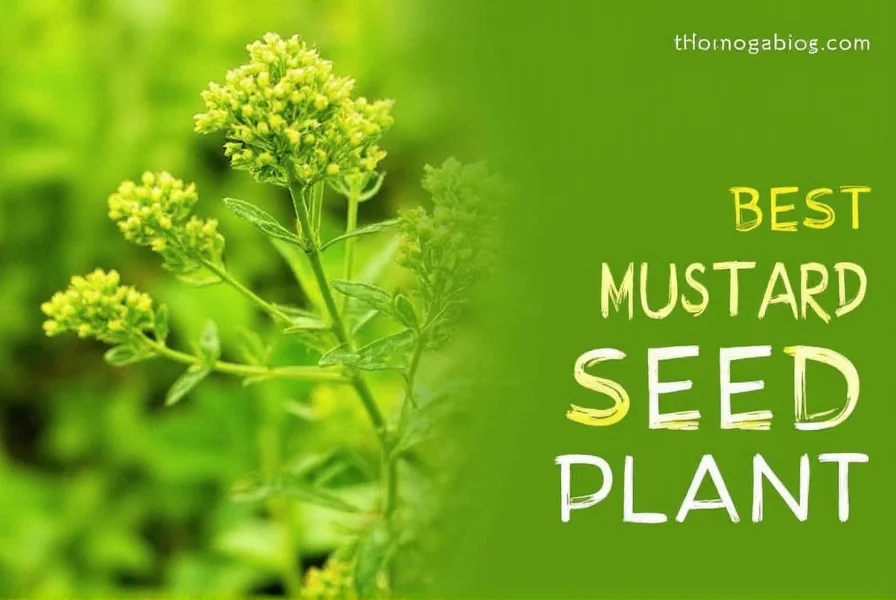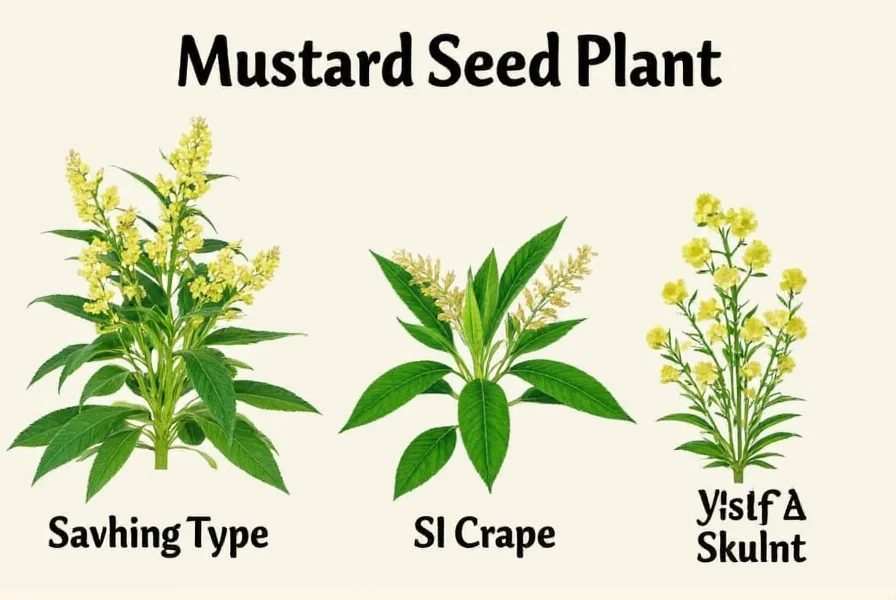Mustard seed plants have been cultivated for thousands of years across diverse climates, from the Mediterranean to South Asia. These hardy members of the Brassicaceae family thrive in temperate conditions but demonstrate surprising adaptability to various growing environments. Understanding the complete life cycle and specific requirements of mustard seed plant varieties helps gardeners and farmers maximize their harvest potential.
Botanical Characteristics and Varieties
Mustard plants share common botanical features while exhibiting distinct characteristics across varieties. All produce four-petaled yellow flowers arranged in clusters, followed by seed pods containing the valuable mustard seeds.
| Variety | Scientific Name | Seed Color | Height | Flavor Profile |
|---|---|---|---|---|
| Black Mustard | Brassica nigra | Dark brown to black | 6-8 feet | Strongest, most pungent |
| Brown Indian Mustard | Brassica juncea | Brown | 4-6 feet | Hot, slightly bitter |
| White/Yellow Mustard | Sinapis alba | Pale yellow | 3-5 feet | Mild, slightly tangy |
Each variety serves different culinary and agricultural purposes. Black mustard plants produce the most intense flavor but are challenging to harvest mechanically due to their tall stature and tendency to shatter pods. Brown Indian mustard dominates commercial production for Dijon-style mustards and is increasingly popular for growing mustard seeds in containers due to its moderate height. White mustard offers the mildest flavor and grows most reliably in cooler climates.

Growing Requirements and Conditions
Successful mustard seed plant cultivation depends on understanding specific environmental needs. These cool-season annuals perform best when planted in early spring or fall when temperatures range between 45-75°F (7-24°C).
Soil requirements significantly impact plant health and seed production. Mustard thrives in well-drained loamy soil with a pH between 6.0-7.5. While adaptable to various soil types, best soil for mustard plants contains moderate organic matter. Heavy clay soils require amendment with compost to improve drainage, while sandy soils benefit from added organic material to retain moisture.
Proper watering practices support optimal growth. Mustard plants need consistent moisture, particularly during germination and flowering stages. Water deeply 1-2 times weekly rather than frequent shallow watering. During dry periods, maintain soil moisture to prevent premature bolting. Mulching helps conserve moisture and suppress weeds that compete with young mustard seedlings.
Planting and Care Timeline
Follow this timeline for successful mustard seed plant care:
- 4-6 weeks before last frost: Start seeds indoors or sow directly when soil reaches 40°F (4°C)
- Germination: Occurs in 7-10 days at optimal soil temperatures
- 3-4 weeks after planting: Thin seedlings to 6-12 inches apart depending on variety
- 6-8 weeks after planting: Apply balanced fertilizer if growth appears slow
- Flowering stage: Monitor for pests like aphids and cabbage loopers
- 80-95 days after planting: Begin monitoring for seed maturity
For gardeners with limited space, growing mustard seeds in containers proves surprisingly effective. Choose pots at least 12 inches deep with adequate drainage. Fill with quality potting mix and plant 3-4 seeds per container. Once established, thin to the strongest plant. Container-grown mustard requires more frequent watering but offers excellent control over soil conditions.
Harvesting and Processing Mustard Seeds
Timing your harvest correctly determines seed quality and yield. When to harvest mustard seeds depends on observing the seed pods. Harvest begins when lower pods turn brown while upper pods remain green. This staggered maturity requires either multiple harvests or cutting the entire plant when approximately 60% of pods have turned brown.
The traditional harvesting method involves cutting stalks just before complete maturity and hanging them upside down in a dry, well-ventilated area. As pods dry, they release seeds into collection containers. Modern commercial operations use combines with special settings to minimize seed loss during mustard seed harvesting.
After harvesting, proper drying and storage preserves seed quality. Spread seeds in a single layer on screens or paper in a warm, dry location for 1-2 weeks. Store completely dry seeds in airtight containers away from light and heat. Properly stored mustard seeds maintain viability for 2-3 years.

Practical Uses of Mustard Seeds
Mustard seeds serve diverse purposes beyond the familiar condiment. Culinary applications include:
- Whole seeds for pickling and spice blends
- Ground seeds for traditional mustard preparation
- Mustard oil production (particularly from brown varieties)
- Flavoring for Indian, European, and African cuisines
- Seed sprouts for salads and sandwiches
Agricultural uses demonstrate the plant's versatility. Farmers incorporate mustard as a mustard cover crop to suppress nematodes and soil-borne diseases. The plant's deep roots break up compacted soil while its rapid growth outcompetes weeds. When incorporated into soil as green manure, mustard adds organic matter and nutrients.
Traditional medicinal applications, while not scientifically verified for all claims, include using mustard seeds for respiratory relief, muscle pain treatment, and digestive stimulation. Modern research continues investigating potential health benefits associated with compounds in mustard seed plants.
Common Challenges in Mustard Cultivation
Gardeners may encounter several challenges when growing mustard. Understanding these issues helps maintain healthy plants:
- Pests: Aphids, cabbage loopers, and flea beetles can damage leaves. Regular inspection and organic insecticidal soaps provide effective control.
- Diseases: White rust, downy mildew, and clubroot affect mustard plants. Rotate crops annually and ensure proper air circulation to prevent disease spread.
- Environmental stress: Extreme heat causes premature flowering and reduced seed production. Mulching and consistent watering mitigate temperature stress.
- Pod shattering: Some varieties, particularly black mustard, release seeds prematurely. Harvest slightly early and finish drying indoors to prevent loss.
For optimal results with organic mustard seed cultivation, implement integrated pest management strategies, maintain soil health through crop rotation, and select disease-resistant varieties appropriate for your climate zone.
Frequently Asked Questions
How long does it take for a mustard seed plant to mature?
Most mustard seed varieties reach maturity in 80-95 days from planting. White mustard typically matures fastest (around 80 days), while black mustard may take up to 95 days. The exact timeframe depends on growing conditions, with cooler temperatures extending the maturation period.
Can you grow mustard plants in containers?
Yes, mustard plants grow well in containers with proper care. Choose pots at least 12 inches deep with good drainage. Fill with quality potting mix, plant 2-3 seeds per container, and thin to the strongest plant. Container-grown mustard requires more frequent watering but adapts well to patios and balconies.
What are the ideal soil conditions for growing mustard seeds?
Mustard plants thrive in well-drained loamy soil with a pH between 6.0-7.5. The best soil for mustard plants contains moderate organic matter. Amend heavy clay soils with compost for better drainage, while sandy soils benefit from added organic material to retain moisture and nutrients.
How do you know when mustard seeds are ready to harvest?
Mustard seeds are ready for harvest when the lower seed pods turn brown while upper pods remain green. This typically occurs 80-95 days after planting. Harvest the entire plant when approximately 60% of pods have turned brown, then hang upside down in a dry location to finish drying and release the seeds.
What are the main differences between mustard seed varieties?
The three main mustard seed plant varieties differ in appearance and flavor. Black mustard (Brassica nigra) grows tallest (6-8 feet) with dark seeds and the strongest flavor. Brown Indian mustard (Brassica juncea) reaches 4-6 feet with brown seeds and hot, slightly bitter flavor. White/yellow mustard (Sinapis alba) grows 3-5 feet tall with pale yellow seeds and the mildest flavor profile.











 浙公网安备
33010002000092号
浙公网安备
33010002000092号 浙B2-20120091-4
浙B2-20120091-4